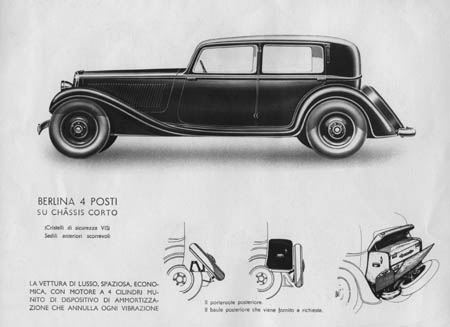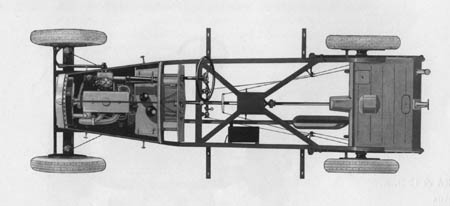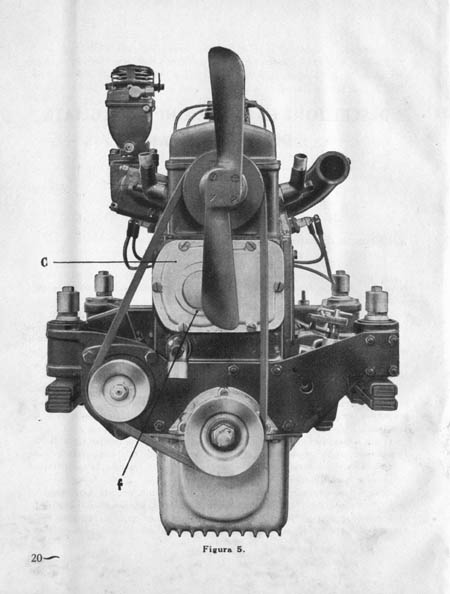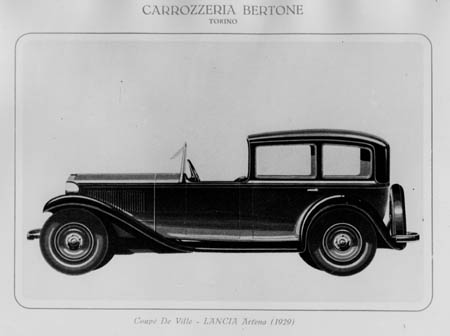
Lancia Artena
Production of the Lambda ended in 1931, when Lancia launched two new models as its replacement rather than one; the 2.6 litre V8 Astura and the 1.9 litre 4-cylinder Lancia Artena, using fundamentally similar underpinnings. The larger 4-litre V8 Dilambda continued alongside the new models until 1936.
Sometimes dismissed as an ‘updated Lambda’, the Lancia Artena shared nothing with its predecessor but its V4 engine configuration and its badge. Its engine’s dimensions were 82.55×90 mm, displacing 1.924cc and producing 58 bhp at the relatively high engine speed of 4.000rpm. Its cylinder block was cast iron rather than alloy, and its overhead camshaft was driven by chain rather than gears. Although sliding pillars still suspended the front wheels, they did so while attached to a substantial axle. Its chassis comprised welded box sections rather than the Lambda’s monocoque (or its later coachbuilders’ platform), its luggage locker was an extra-cost option rather than integral with its frame, and its standard wheelbase was 280 mm shorter than that of the Lambda.

Lancia Artena: Light, compact and strong cruciform chassis frame of the Artena
Perhaps the Artena’s most distinctive feature was the manner of mounting its engine. Attached to four arms were vertical coil springs in Silentbloc bushes, which in turn rested on short leaf springs attached to the chassis. This system damped the vibrations of a large-ish four cylinder engine so effectively that testers had difficulty sensing whether they were driving behind four, six or even eight cylinders. This was long before Mitsubishi’s counter-rotating shaft smoothed the motion of big fours like those in its 2.6 litre Magna, or Porsche’s 2.5 litres 944 or the 3.0 litre 968. Contrary to some accounts, the Lancia Artena system was not used on the Astura, which with its eight cylinders was always praised for its smooth running on conventional mounts.

Lancia Artena: Front view of the Artena engine, showing its unique engine mountings
While the Artena was certainly the less well endowed of the two models, it would reach 115 km/h carrying a factory saloon body. With 97 km/h possible in third, many of its contemporaries with engines of similar size were gasping at that speed in top. Its engine was sited well back in its chassis, and the Artena was noted for the sweetness of its handling.
The Artena and the Astura were available with factory-supplied coachwork, but for the first series the Artena’s wheelbase was 187 mm shorter than the V8 car; for the second series the longer wheelbase was standardised, despite the Artena’s shorter engine. From the introduction of the third series in 1934, standard and short or corta wheelbases were available, and some handsome sporting bodies appeared on the shorter frames. Those cars weighed only 860 kg in chassis form, accounting in part for their very lively performance. In fact the early series 2.606 cc V8 Astura only beat the Artena by about 5 km/h in top speed, even though it got there faster.

Lancia Artena: Early coachbuilt coupé de ville on the long second series Artena chassis by Bertone
From the third series, the factory-supplied Berlinas – in 4-seater and 6-seater form – applied the lessons learned from the Augusta, released in 1933, by offering pillarless construction but did not employ the smaller car’s monocoque. Michelin disc wheels were offered as standard equipment, but Rudge-Whitworth wires were optionally available, and were more commonly fitted to third series cars.
As the factory’s middle-weight four cylinder car, the Artena was superseded by the Aprilia late in 1936, but there was life in the model yet. After the outbreak of World War 2, the Italian military demanded chassis on which ambulances, light trucks and staff cars could be constructed, and so in 1940 the Artena was revived as the Tipo 341 Militaire and the Tipo 441 ambulance. Built on longer 3.180mm wheelbases, these cars were driven by a slightly detuned version of the original Artena motor, producing 51 bhp, and driving through shorter gearing to allow maximum speeds of 105 and 95 km/h respectively. The military versions were produced to 1943, but even then Artena engines were installed in the last of the Lancia E290/291 electric vehicles at the close of the War, when domestic fuel supplies became more freely available.

Lancia Artena: Revival for war service in 1941 after the end in 1937
Some 5.060 civilian Artenas in three series were built between 1931 and 1936, to which were later added 507 of the military versions. Swift and nimble, the model deserves to be recognised as another feat of Lancia engineering in its own right, rather than as an appendage of the Lambda.
B. Lindsay / 8.2013

